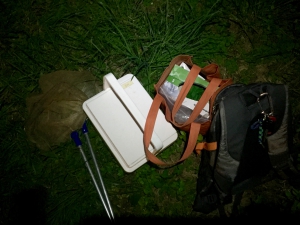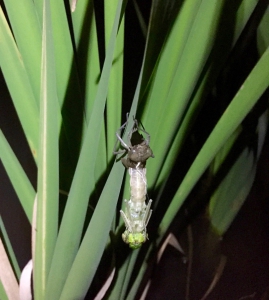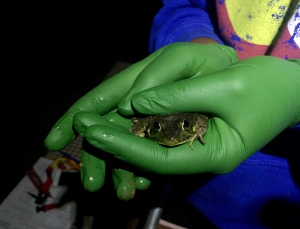To increase the sample size of my study, we’ve decided to search for adult frogs at night. We’re assuming that elevated daytime temperatures cause the frogs to seek refuge under water or in dense plant thickets and that they’ll be more visible and/or active at night during cooler periods.
Typically this exercise involves arriving at a wetland and listening to the natural evening serenade to deduce which amphibian species are present and at what frequency they’re communicating. Then we begin circling the wetland to localize calls or identify “plops” as Green frogs jump from terrestrial perches into the water. Sometimes you can visualize them swimming away or see their eyes and mouth positioned above the water.
While searching in the darkness it feels as though Mother Nature is thwarting your every move; insects swarm around your headlamp (distorting my already sub-optimal night vision), mosquitoes bite you, wetland flora tickle and entangle you along the waters edge and wetland fauna are aptly camouflaged to blend in with their murky surroundings. To put it lightly, frog catching is no walk in the park.
Desirable qualities of a frog-catcher include:
- patience
- the art of soundlessness (this skill is really hard for me)
- swiftness
- determination
My overall respect for frogs, and amphibians in general, has skyrocketed during this summer experience. Their intelligence and athletic agility do not go unnoticed. Quite frankly, they remind me of tiny pond ninjas kicking, leaping and clinging their way through all varieties of substrate. They play stoic when spotted with a flashlight along the shoreline but as soon as a net or hand swoops down for the catch they spring in any imaginable direction to evade escape – brilliant! They were even jumping out of our nets, after we’d caught them, from heights of 3+ feet! Due to these incredible defense mechanisms, we only successfully caught and swabbed one frog. On the upside, this was great practice for next week!

Bare minimum field supplies. Don’t forget your headlamp!

Green darner dragonfly emerging from it’s casing (this process is called exuviating)

Green frog (Lithobates clamitans) was our first night catch

